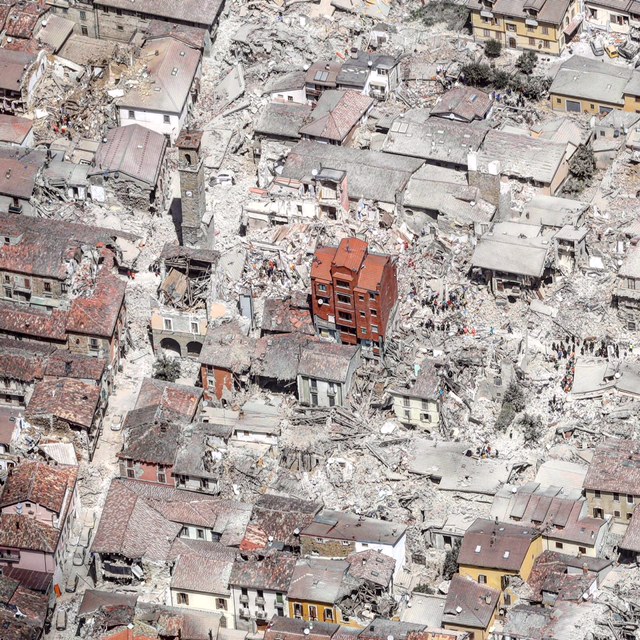
Dear Blog Readers – this is my lengthy, diary-like, behind-the-scenes account of covering the 6.2 magnitude earthquake that hit Italy one week ago. It will probably be boring to many people but it does give a good idea of how we cover a major news story. As on many big news stories there were moments of heart-rending sadness, moments of exhaustion and moments of silliness. I hope not to offend anyone by recounting some of the humor; it was just a way to release the tension.
I was sleeping at home alone in bed in Rome when the earthquake struck; the rest of my family was still on vacation. As the bed shook, I jumped up and turned on the light to look at the overhead lamp. Someone once told me the best way to recognize an earthquake is when overhead lamps start swinging back and forth. My bedroom lamp was swinging. I ran into my daughter’s room. Her bedroom lamp was swinging. I picked up my cell phone. A message arrived from AP cameraman Paolo Lucariello “Anyone feel an earthquake?”
And that was it, AP was off and running…a flurry of messages as we checked where the epicenter was and one team departed immediately.
I did not want to go because I had gotten an ugly eye infection while I was on vacation and I was hoping to see a doctor the next morning to get some medication.
By the time I got into the office the next morning it was clear the earthquake had created massive devastation. After a quick trip to the eye doctor, I left with AP cameraman Gianfranco Stara and AP photographer Gregorio Borgia. Our first stop was a heliport outside Rome where we were to get on a helicopter to fly over the earthquake zone and take photos and film.
Gianfranco, Gregorio and I became a sort of three media musketeers (Three Stooges might be more apt) AP team roving the earthquake zone, so before I continue let me say a brief word about the three personality types.
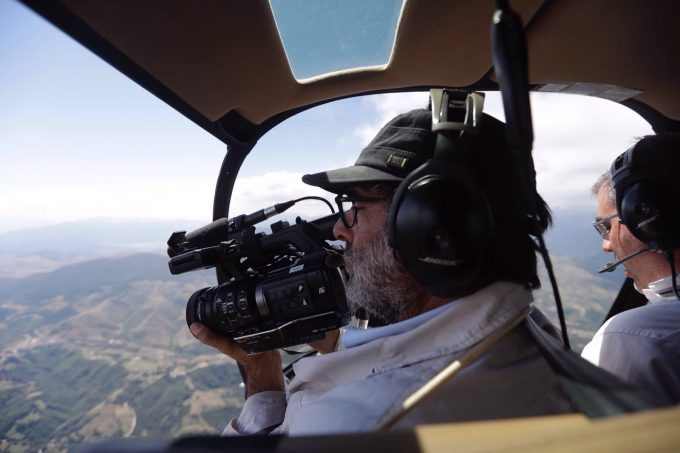
Gianfranco Stara is a cameraman in his late fifties who has covered the wars in the Gulf and the Balkans. He has traveled with various Popes all over the world (mostly with me) and pretty much done every story there is to do in Italy over his career. He smokes a pack of cigarettes a day and reads “Il Manifesto” every morning. He loves hard news, can’t be bothered with light stuff, and gets fed up with modern technology pretty quickly. He is of Sardinian blood and has those well-known Sardinian qualities of being stubborn as a mule but extremely determined and loyal. He has an incredible talent of being able to cat-nap anywhere to gather energy on a big story. Over the years I have seen him taking a short snooze on aircraft carriers, helicopters, cars and transport planes. He then wakes up and is fully charged and ready to keep on working. In addition to being a talented cameraman, he is a phenomenal cook.
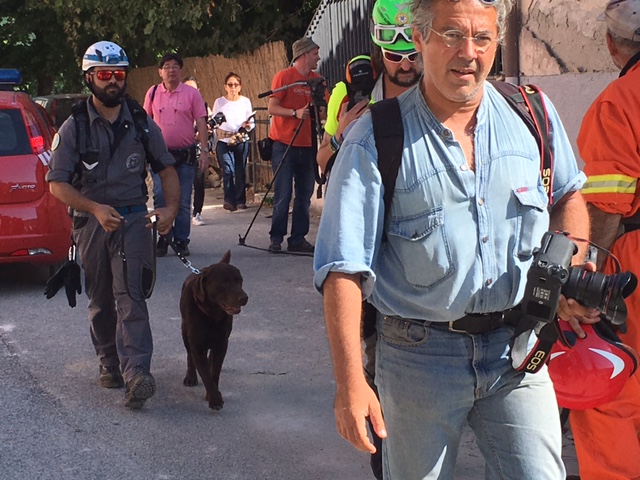
Gregorio Borgia is a gregarious, funny photographer in his early forties. We tease him about being a descendent of the Borgia Pope but he denies any connection. He has got a head full of long, curly, grey hair, which he pulls back in a ponytail or wears down to his shoulders. Gregorio is a star on Instagram with over 18 thousand followers. A colleague gave him the befitting nickname Mr. #NoFilter because he spits out whatever comes into his head which can be hilarious or cutting. In addition to a girlfriend, Gregorio has a constant flow of calls and text messages from women friends desperate to have long conversations with him seeking personal and professional advice. In between snapping photos, Gregorio was dealing with all of them.
Then there is me, mozzarella mamma, a 52-year-old TV journalist with relentless energy. In the field I am hyperactive, in constant motion, walking, talking, tweeting, telephoning, instagramming, and making contacts with everyone I can. I want to see everything, film everything and talk to everyone. This was driving Gianfranco and Gregorio insane by the end. (On top of being annoying, I was a grim sight to see with my puffy, oozy infected eye but I was not going to let it stop me.)
HELICOPTER
When we arrived at the heliport we could see right away that the helicopter was petite. It had a glass front and open sides. They pilot said they would have to fly high above the area to stay out of the way of rescue helicopters. He had put extra fuel in so they could go a little farther and there was no way I could join the team in the air. I set up my computer in the pilot’s office and off they went.
Gregorio, who is afraid of heights, said he spent the first part of the ride as they buzzed towards Amatrice with his eyes squeezed tight shut. “That wasn’t a helicopter, it was a mosquito we were flying on!!” he told me. Nevertheless, he managed to take a photo that made the front pages of papers and magazines around the world. Above is one of his extra shots that he has given to me.
A few hours after the helicopeter ride, Gregorio was asked to comment on the earthquake for AP radio. If you are interested, here is the link: GREGORIO BORGIA AP RADIO EARHTQUAKE
PESCARA DEL TRONTO
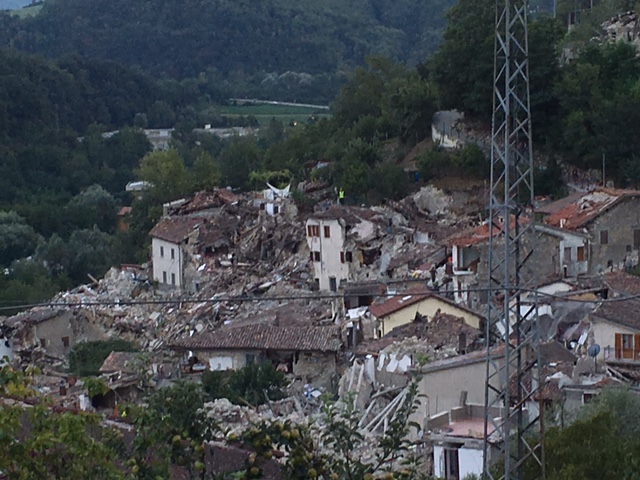
From the Heliport we were instructed to go to the medieval hamlet of Pescara Del Tronto because there were reports that it had been razed to the ground by the earthquake. Our crews had already been working for hours in the ravaged town of Amatrice but there were apparently lots of people still under the rubble in Pescara Del Tronto and we did not have any coverage.
Due to so many damaged roads that had been closed down by police, we chose an alternative route driving up through Terni, Spoleto, after Spoleto we began hitting road blocks and had to go up and over the mountains on small roads to get to Norcia. After Norcia there were hardly any cars and we passed several roadblocks as we got closer to Pescara Del Tronto. We told the police we were journalists and they let us go ahead. Finally we got to a series of spookily deserted tunnels through the mountains on an empty highway. There were big bumps in the road where the earthquake and pushed sections up or down. Suddenly we emerged on a highway embankment on enormous columns that stretched along the side of a valley and below us we could see the pile of rubble that was once Pescara Del Tronto.
There were clouds of dust coming up and rescuers who looked like tiny toy soldiers below. On a small patch of grass they were lining up the dead bodies wrapped in white clothes that from above looked like sticks of gum.
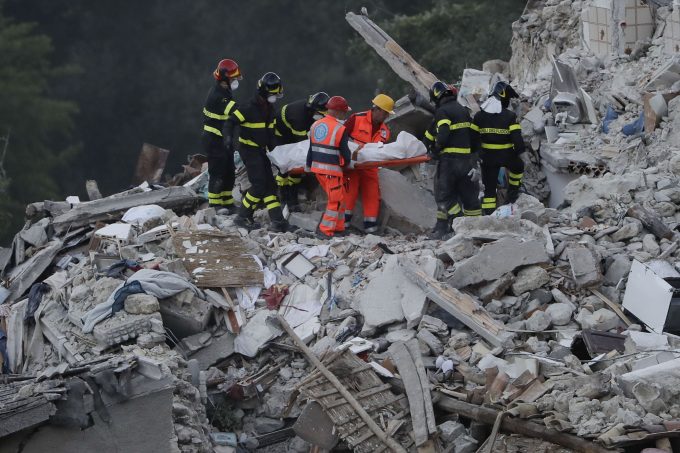
Gianfranco parked the car near the entrance to the tunnel at the end of the highway embankment and I rushed back up to the middle trying to find the best position to go live. Gregorio got out his cameras and started clicking photos. For safety reasons Gianfranco did not want to go back to the center of the highway embankment so we went about a quarter of the way up and set up our equipment to put out a live picture. The signal was so bad in the mountains that our shot was pixelating. A colleague in London explained to me that if we switched the camera to standard definition and sent the live shot with a 30 second delay the quality would improve. We were trying to make these changes when a big aftershock shook the whole embankment. That was it. We gathered up our equipment and hopped back in the jeep and rushed down to the town below.
On entering the town I snapped this photo of Danilo Dionisi, one of the firemen involved in the operations. He was exhausted but told me there were still people alive under the rubble.
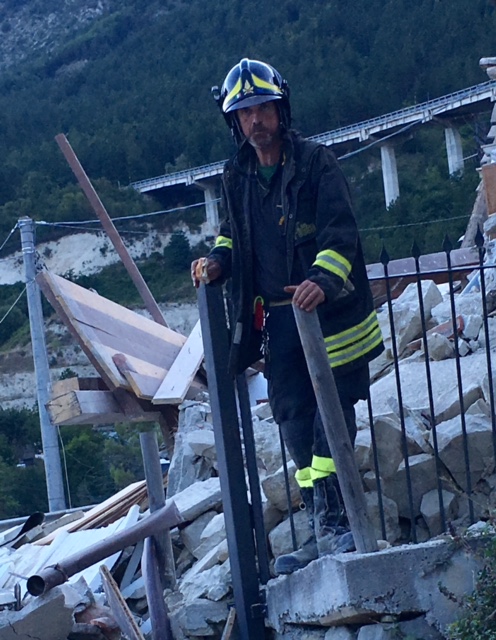
We were not allowed into the lower end of the town where the firefighters were working so we filmed from a distance.
Well into the evening an ambulance came rushing past with sirens blaring. They had pulled a little girl out alive from under the rubble. Later we learned it was Giorgia Rinaldo, a 4 -year-old girl whose sister Giulia died on top of her, protecting her from the debris.
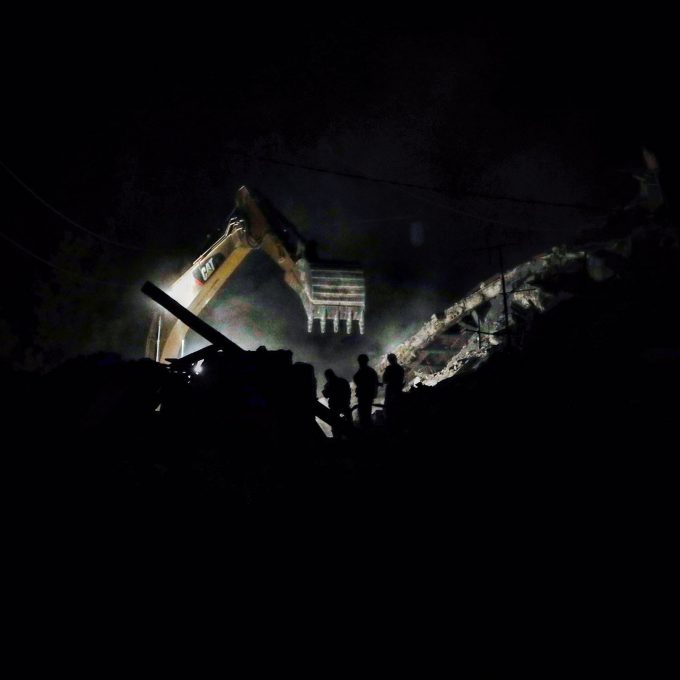
That night we drove down to the nearest town that was left standing, Acquasanta Terme. All the rescuers were gathering around a little coffee shop that was open all night. The owners were very kind and let us plug in our battery chargers all night there. Gregorio quickly named the coffee bar the “Bar Sozzo”, the dirty bar because it wasn’t exactly spanking clean, but we were so grateful for their generosity. Without our batteries charged we could not have used our cameras, computers, mifi or telephones.
We camped out that first night in the car outside the “Bar Sozzo”. Being two chivalrous gentlemen, Gregorio chose to take his sleeping bag and sleep on a bench, Gianfranco slept reclined in the front seat, while I got the luxury of stretching out on the back seat. After tossing and turning for hours, a strong aftershock woke us around 5:30am and we got up, had a coffee at the “Bar Sozzo” and headed back to Pescara Del Tronto.
As the sun rose over Pescara del Tronto, we were the first to pull up above the town. As usual, I rushed ahead dragging bags of equipment. Our desk wanted us up live by 6am and I wanted to choose the best position.
Two big, dirty, white sheep dogs that had been there the night before came charging out barking at me. I retreated quickly. I then turned around and tried another strategy. I used the silly baby-talking tone I use with my cocker spaniel “that’s a good boy, that’s a good boy, that’s a good boy” and the sheep dogs settled down. Gianfranco and Gregorio were behind me laughing. “What the hell language was that?” Gregorio asked. “English.” I responded. “Sure didn’t sound like it,” answered Gregorio. “Ok, let’s call it doggy English.” “Well whatever it is, teach me so I can use it next time,” said Gregorio mumbling “batz a boo buoy, batz a boo bouy” as we headed past the dogs down the road.”
Interestingly, over the course of the five days thatwe were working in towns badly destroyed by the earthquake, there were hundreds of aftershocks and tremors – every time the dogs sensed them a few seconds before the humans and jumped up and began barking.
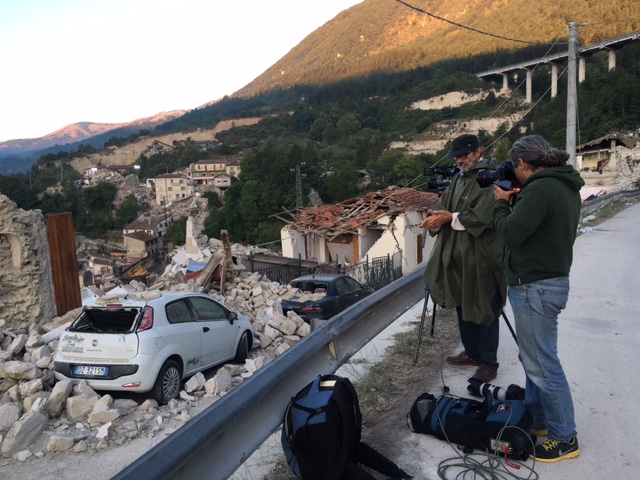
Gianfranco remained at the top of the town filming from a distance as the firefighters began the search again. Since no one was blocking us anymore Gregorio and I wandered down into the town to see what the rescuers were doing. With the morning sun behind us, we cast long shadows on the road split by crevices.
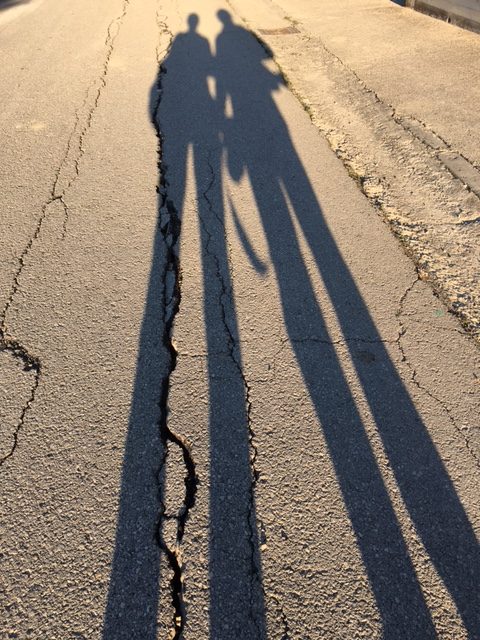
THE ALBANIAN NUN
One of the first people to get to Amatrice, the town most devastated by the earthquake, was Valentina Onori, a freelancer who works with AP Television. She had been on vacation at her family’s home in Leonessa. She rushed to the scene and immediately started filming video with her cell phone and sending it to AP. She had incredible shots and they were the first that many people around the world saw. Among her shots was a nun, lying by the road looking at her cell phone, her head bloodied. A photographer with the Italian news agency ANSA also snapped the shot and it quickly became one of the iconic photos of the earthquake.
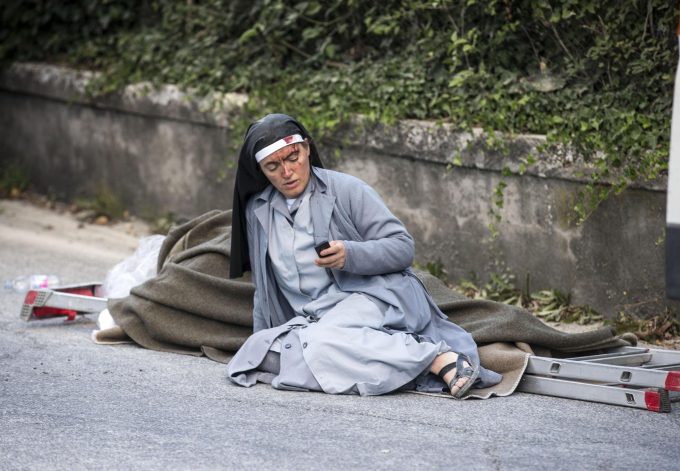
AP sent Gianfranco, Gregorio and me on a mission to follow up on these initial images and find the nun and interview her. We caught up with her in Ascoli Piceno. She is a 35 year-old nun from Albania named Sister Marjana Lleshi. We found her at a home for her religious order, the Sisters of the Handmaidens of the Lord, in Ascoli Piceno. She was clearly still shaken up as she sat on a bench outside in the garden and let me interview her. She was wearing a clean veil with no sign of blood, but she said underneath she had some painful zig-zag stitches.
She spoke about how the building collapsed in on the Don Minozzi convent in Amatrice while she was sleeping. She tried to escape through the door but her path was blocked by rubble. She could not find another way out. Debris was falling from the ceiling and she said she felt very cold. She wrapped herself up in some extra clothing, crawled under the bed with her cell phone and began texting close friends telling them she was going to die. Eventually she was rescued by a young man named Luis who cared for one of elderly woman who was staying at the home for the aged there.
When she made it out, she sat on the ground on the road outside next to a victim and began texting others that she was alive. Our freelance video-journalist Valentina Onori caught her in a bit of video later scurrying across the rubble trying to get out of the way of a bulldozer.
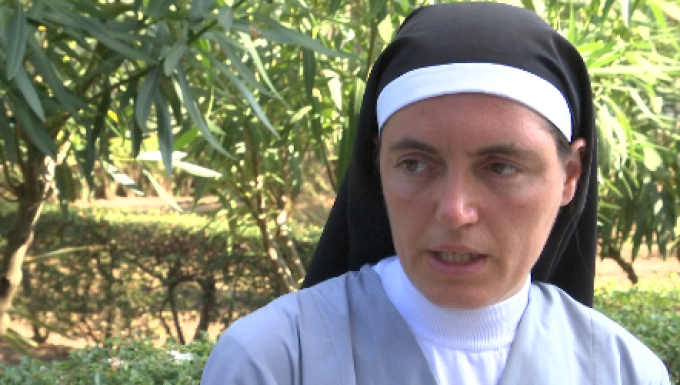
As she told me her story, Marjana eyes filled with tears when she spoke about the sisters from her order who died in the quake and about her family back home in Albania. She said she did not send a message to her family in Albania when she thought she was going to die because she thought it would be such an emotional shock to her father that he might not survive. I asked her if her family might come visit her now, or if she might go to see them and the tears rolled down her face.
She told me if they tried to come her brother and sister would lose their jobs. “I cannot risk that my brother and my sister end up in the street just to come see my face. I cannot allow that,” she said crying.
The interview was long and it took me hours to get through the edit. I worked with AP Rome’s talented Bureau Chief Nicole Winfield to get the story out for TV and AP wire.
ACCUMOLI – THE EPICENTER
We wound our way up a narrow road to the epicenter in the town of Accumoli. The small piazza in the center of town was packed with firefighter trucks, civil protection workers and a few residents sitting outside on plastic chairs. The Mayor, Stefano Petrucci, was rushing around consulting with others on the clearing out of the rubble and stabilizing of buildings. Gregorio, Gianfranco and I quickly found the church whose bell tower came crashing down killing a family of four living in the home next door. Restoration had been done on the church to have it meet anti-seismic standards. Prosecutors are now investigating. There was nothing left of the home next door. The back wall of the church was still standing and behind the swinging chandeliers we could see a broken cross dangling; the figure of Christ had lost an arm and his eyes seemed to stare sadly at the wreckage below.
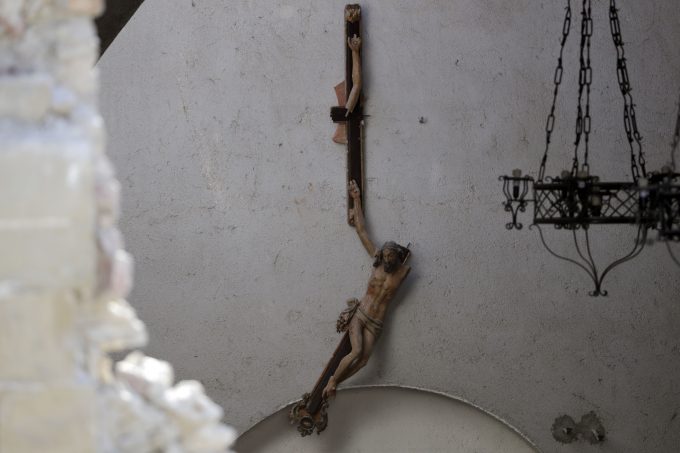
SOMMATI
Our editors in London urged us to reach the town of Sommati, a remote hamlet that had received next to no news coverage. A British family had been living there and were apparently trapped beneath the rubble. Again, Gianfranco, Gregorio and I took a series of back roads and finally found an intersection in a road where lots of cars were parked. There was a van taking journalists and anyone else who wanted to go up to Sommati. We took the van. As it wound it’s way up towards Sommati, I was sitting in the van frantically editing our report on Accumoli and another one on a chocolate Labrador named Klaus who we had met there that was helping search for bodies under the rubble across the earthquake zone. This is the way an agency works now, constantly on the move editing, feeding, writing without any time to stop and contemplate. There is so much pressure to get the news out fast.
The van stopped at another place along the road and we all piled off. I bumped into my friend Courtney Walsh from FOX News who was getting on the van to head back down. She said the police were stopping everyone at a roadblock, that Sommati was several kilometers away and they would not let journalists through.
As we walked up of the road, I could see a big group of journalists at the roadblock. There were lots of cars, firefighter trucks, civil protection vehicles, and police. I looked dirty and scruffy and was dragging my computer bag and the tripod. I crossed the road and breezed past the police block just as a Civil Protection vehicle was going through. Maybe the police didn’t think I was a journalist. Gregorio and Gianfranco came rushing along behind me. I took off down the road walking as fast as I could. Gianfranco started yelling at me “Trisha! Ma dove vai????” (Where are you going?). I turned around and silently waved to him to come on. Gregorio was coming up behind him equally irritated. I went on about 100 meters until we were out of sight of the roadblock around a turn. “It’s 15 kilometers to Sommati,” said Gregorio, “I am very happy to wait for you guys right here, but I am not walking 15 kilometers up a mountain.”
“Guys, we just got past a road block with tons of journalists,” I snapped, “just keep on walking and we will try to hitch a ride. “Journalists have not gotten into this town yet, we need to get up there first.” I turned and kept on walking. We pushed on sticking our thumb out at every car that passed. Finally a dirty Fiat Uno pulled over, its back seat packed with stuff. Inside was a survivor from the town of San Lorenzo e Flaviano, a part of Sommati. He told us to climb in even though there wasn’t much room. Gianfranco took the front and Gregorio and I crammed into the back. There was a big jar with a red lid with what looked like pickles in a liquid sitting on the seat. I held it in my lap as we started up the steep road. The man began telling us about how he had lost everything in his home, and his mother’s cousin had died in the quake. I looked down at the jar in my lap. It had some masking tape on it with “Fegato” (liver) written on top. I asked the man about it. “That liver is all I managed to save from my home,” he said laconically, adding, “and I am going to be sure to eat it.”
When we were nearly at the town we passed a TV crew hiking up. Gianfranco and I immediately recognized them. They were the snarky Sky UK team from the Garibaldi (see blog post: “The Great Garibaldi Press Mess“). Some hyper-competitive journalistic instinct kicked in as soon as Gianfranco and I saw them. We got out of the Fiat and rushed into Sommati. Some firefighters told us where the home of the Brits was but told us it was too dangerous to reach. We pushed on, heading down a narrow road with teetering buildings on both sides. Gregorio stopped in the middle of the road to take a photo of a crumbling home that looked to me that it was about to topple down. I put down my stuff and looked up to see the SKY UK crew coming up the road.
“C’mon Gregorio, let’s move, we have to go. We need to find the house of the British family, it is up here,” I urged, “c’mon!!”
“JUST LET ME TAKE A FUCKING PHOTO,” Mr. #NoFilter snapped. He was right. I was harassing him to move and not letting him work.
We headed down a narrow alleyway that curved between crumbling homes. I was extremely agitated. Then we saw the house. Its white front look pretty much intact with just a few cracks. A little black mailbox was on the front gate with the family’s name Henniker Gotley. I took a photo of it. The British crew arrived. I slipped back out and found a side road leading around to the back of the house. It was completely gone, just a pile of rubble. Gregorio and Gianfranco came around and began photographing and filming. I took a picture of them behind the house and then tweeted a photo of the destroyed home.
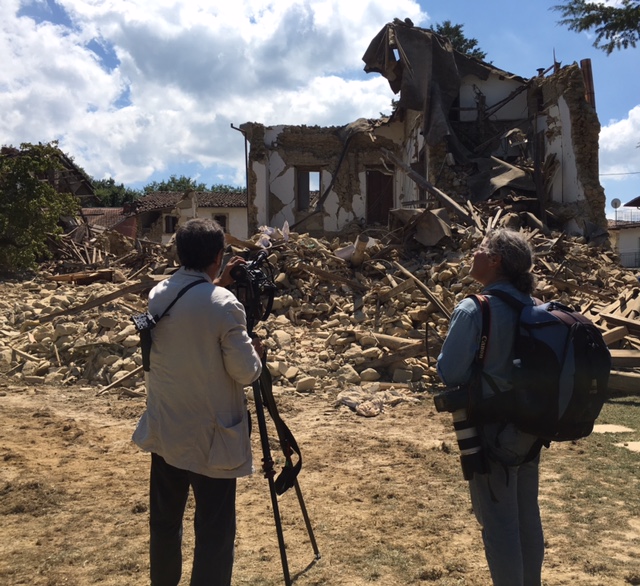
Immediately I got a call from my Argentinian friend Julian Miglierini, a producer for the BBC, who had seen my tweet. He wanted a pin location on the house. As Gianfranco and Gregorio worked, I wandered around the garden looking at the beautiful roses, the lawn chairs, the hammock and the swimming pool. Will Henniker-Gotley and his wife Maria died in that home along with a 14-year-old who was visiting their family, Marcus Burnett. The Henniker-Gotley children survived.
It was heart-rending, as was the stories of all the others we were covering.
We finished filming and I was eager to get more information so we walked out to a nearby field where the firefighters had set up their command center. They did not want to give me an interview, they said they did not have the authorization. Finally I called my friend, Luca Cari, who is head of communications for the Italian firefighters in Rome. I got to know Luca covering the Costa Concordia shipwreck and had seen him recently in Lampedusa. He told the firefighters they could give us an interview.
They told us about pulling the bodies out from the rubble and then found me a survivor I could interview who told me how she escaped from her home in her pajamas with her three children. It was harrowing.
(The firefighters also let me charge up my phone battery in the mobile command center. My battery was nearly dead.)
I sat down in an open space and began to edit and file. I was determined to get out my Sommati story before the others. In addition to the BBC, the UK’s Channel 4 was eager to get it. Shortly after I filed, an ITN crew arrived. At that point we left. We had more stories to cover.
STATE FUNERAL IN ASCOLI PICENO
On Friday we had to cover the state funeral in Ascoli Piceno for 35 of the victims. We got to the community gym where the coffins were lined up the evening before. Family members were gathered around weeping. From a distance we filmed two small white coffins. One was nine-year-old Giulia Rinaldo who died in Pescara del Tronto, her arms wrapped around her younger sister Giorgia. The other was 18-month year old Marisol Piermarini from Arquata.
The night before I had to set up our coverage. Italian state television RAI was handling the live pool inside the gym. The president of Italy, Sergio Mattarella, and Prime Minister Matteo Renzi were coming. I needed to get access to RAI’s pictures on the ground since we were only allowed one camera inside. I called up the producer for RAI who was going to be running the show. “Hi, I am Trisha Thomas from AP Television, I think we were together on the Aircraft Carrier Garibaldi last week,” I said. “I was just wondering if we can attach our cable to the back of your truck and record the live feed of the Mass..”
“Ah yes,” Giovanni replied very enthusiastically, “of course I remember you. You are the tall, blond one.”
My heart sank. He was clearly thinking of the Reuters TV journalist, the beautiful, very tall, very blond Hanna Rantala from Finland. Aaarggh!!!
“Well, actually, no. I am the other one. The over 50, average height, not blond TV journalist for the Associated Press.” I sputtered (It was a good thing we were on the phone and he couldn’t see my gross eye infection on top of everything else.) “But what I lack in beauty I make up for in personality!” I added gamely. Fortunately, he agreed to give us one of the five spots to put a cable on the back of his truck.
AP Television sent a team that was in Amatrice over to help in Ascoli Piceno for the funeral. There was Andrea Rosa from Beirut and Nic Dumitrache from Budapest. They were a welcome sight. I have been with AP Television for so many years that now I associate colleagues with big stories I have done with them. Andrea and I spent a lot of time in Catania doing migrants stories together and Nic was with our team at the Amanda Knox verdict.
The funeral was difficult. Hundreds of people packed inside and the stench was terrible. Gregorio told me he though the bathroom was blocked, but a cameraman told me that from past experiences he knew it was the bodies.
The 35 wooden coffins laid out at the front of the community gym where the altar was located. In the middle were two small white coffins. Before the mass started Nic got moving pictures of the relatives of the little girls crying over their coffins. Our hearts went out to them.
Nic handled the live from inside, Gianfranco handled everything going on on the outside including the crowd, interviews, arrivals of the President and Prime Minister and then the coffins being carried out and put into hearses at the end. Andrea helped me with the editing and writing of the stories.
A man standing outside named Fiore Ciotto seemed to sum up what many were feeling, “The melancholy grabs on to your heart,” he told me. “You feel a sense of weakness, of depression. An event like this weakens you physically and mentally just thinking of all those poor people who are without home and lost family.”
When the Mass was over the they started carrying out the bodies to the hearses, we got some moving video and photos of the firefighters carrying out Giulia’s coffin.
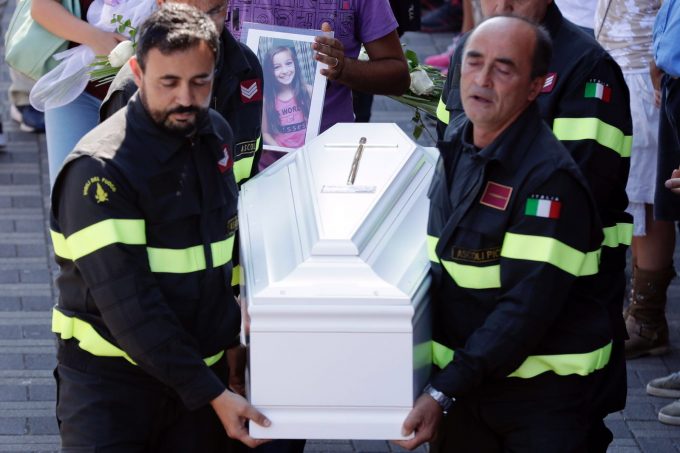
One of the firefighters had written a letter that was on her coffin that said the following:
“Ciao little one, I only gave a hand in getting you out from that prison under the rubble. I am sorry that we arrived too late. Unfortunately you had stopped breathing but I want you to know from up there that we did everything we could to get you out. When I will go home to my house in Aquila I know there is an angel up there who is looking at me from the sky and at night will be a luminous star. Ciao Giulia, even if you never knew me I love you. Ciao, Andrea.”
It is enough to make me cry translating it right now.
But the news never seems to stop and give you time to cry. As soon as the funeral was over and the hearses and left, my London desk editor called and asked us to go film the burials. Gianfranco refused. I insisted. I was worried Gianfranco was going to faint. He had been on his feet filming since 830am and it was 3pm but he refused to eat.
Most Italians do not believe in snacking. If you can’t sit down at a table with a plate of pasta and a glass of wine, they would rather not eat, even when wiped out. It can make working long hours very difficult.
What I know, but did not effectively explain to our desk editor in London, is that in Italy, funerals are very dramatic affairs (see blog post: “Dressed in Black“). On important occasions media is allowed to cover, and family members do not mind one recording their grief. But burials are considered private and media is unwanted. We arrived at the small community cemetery in Arquata, passing the tent camp, and the piles of rubble to find several hearses outside and burials going on inside. We discretely began to film and take some photos from a distance. After about 10 minutes a young woman from the Civil Protection came and asked us to please respect their privacy and only film from the outside of the cemetery. We went and sat on some stone steps outside. A man from the Civil Protection was helping with the traffic outside as the hearses maneuvered to let the fire trucks get past. We heard him on his radio saying, “there are these disgusting journalists here.” Gregorio, Mr. #NoFilter said, “I would like to tell him off, but he is actually right, we are three scavengers, three vultures.” So we left. I did send a short edit of the scene in the cemetery and AP television used it. If there is a next time though, I will refuse to go.
Sad and discouraged we drove back to Ascoli Piceno. Over dinner of pasta all’Amatriciana (served as part of a fund-raising effort for the town of Amatrice) we drank wine and mused about the day. Then the messages started coming in about the assignment for the next day. Our editors wanted us to film a mass in a tent camp. It never seemed to end.
There are a couple other stories worth mentioning. We met a young couple at a roadblock trying to get into Pescara Del Tronto but the police would not let them pass. The man told us his parents had escaped from their home in the town but his sister and brother-in-law were still missing. They wanted to go tell firefighters where the house was located. We helped them get in touch with the firefighters in the town who got a truck and brought them up to help with the search. The next day I ran into the couple in a tent camp. I gingerly asked if they had news. They told me the sister and brother-in-law had been found. They were dead.
On my last day I was encouraged by a lively interview with the local parish priest in Arquata, Father Don Louis Kangombe, originally from Kananga in the Democratic Republic of the Congo. He has been in Italy for eight years. He spoke to me after a mass in the tent camp standing under a cross made out of two firefighter ladders and rescuers helmets. Gesticulating energetically he described that when the earthquake hit, he had no idea what it was. He escaped from the parish residence and ran into the street trying to protect his head from falling glass and debris. Once outside he said he was “inconsolable” because he could not understand what was going on. Local residents hugged him and tried to calm him explaining that it was an earthquake.
Since the night of the earthquake, Father Louis has been living in his car, but at the Mass on Sunday the local Bishop promised that he would ask the Civil Protection unit in the town to give him a tent and a place to celebrate mass.
Following the Mass I wanted to do another story on the firefighters going up into the red zone in the town and entering houses to get out people’s personal effects. Gianfranco and Gregorio put their feet down. We were supposed to pull out and go back to Rome. Basta. So we hopped back into our car and I sat in the back seat and edited the video of our last story on the computer as we wound back out of the mountains away from the earthquake zone towards Rome.
(A final note: A big thank you to my colleagues Gianfranco and Gregorio for putting up with me for five days and for giving me all sort of shots to use in this post. But the three of us were only a small part of the hard-working AP team that pulled together to provide coverage of this story, a big thanks to all of them too.)
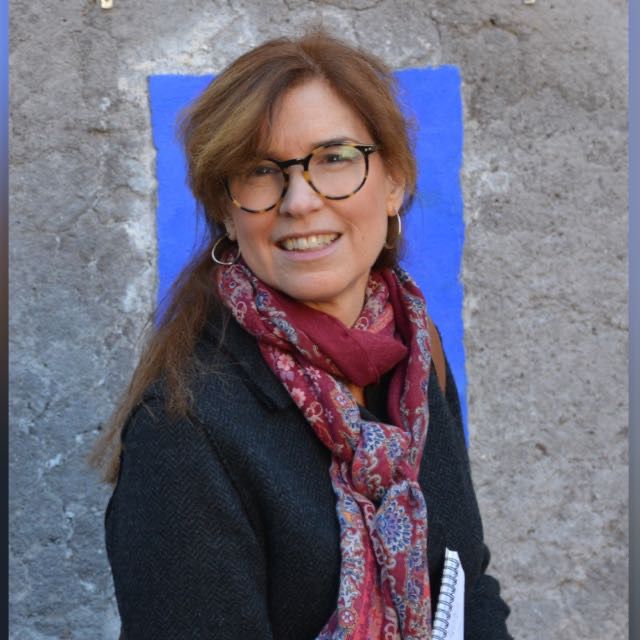
Oh Trisha, I am exhausted (in a devastated but from the trenches informed way because of how well you write a story. THank God, live to tell it)! The night (here) it all happened, I was checking your much loved MM site, glad to be reading your great Garibaldi mess post. And your first note about running off to cover an earthquake!..(.and just then my MM notification came as I was just hearing of the earthquake news here on tv. As Your biggest fan :) I had been grumbling to myself ‘oh right, they are on holiday in the Italian Alps, and I remember she promised the kids in the past that she would not blog while on vacation” But oh my, oh my!
Firstly, my heart goes out to Italy..her heart..all who lost so much and so many in such an awful traumatic tragedy. JUst heartbreaking and truly incomprehensible. And huge thanks to you and posse at AP and , of course Gregorio and Gianfranco your relentless maneuvering and excellent coverage amongst such great physical and mental, emotional challenges to get THe story out to the world. …first!
Excellent, hairraising work, Trisha! THank you.
Many who follow you here, must also have been through equally sudden horrible events, wars , on and on. I went through a cat 5 hurricane on the small pacific island where I live 26 years ago. Fortunately we knew it was coming…a huge blessing. Amazingly no one died, but the destruction to the whole island was total. The morning after the terror, I was groping my way to where my house had been, (I had lived at the beach, so went to a friends house in the interior…both were destroyed. But as I was nearing my property, I saw a cameraman….there are lots of visitors here…filming the detritus where my house had stood….and it dawned on me to ask him to call my Dad on the mainland when he got to a phone, as I was pretty sure he would be able to get out sooner than most. (Remember,few cells back then). WHen I finally got to speak to my Dad, he said cnn, and every network had called him within 24 hours to let him know I was ok. I told everyone else I saw to do same. Appearantly, the news agencies , reporters and camera professionals, like yourselves, have lots of side jobs!
AS I write, we have have a tropical storm And a hurricane heading right towards us. BUt again, and such a blessing, at least we know something is coming.
Annie — thank you so much for your message. I am so pleased to hear of your story about the cameraman who called your Dad. That is wonderful. Sometimes we are seen as terrible vultures, hovering on the edge of other people’s tragedies. But we really do want to help by telling the stories and getting out the news.
PS, I hope your eye has healed ok, and while relentless, I hope you are being careful.
THank you, Trisha, outstanding reporting!
Love and healing to All
Hi Annie — my eye is starting to get better. Taking a long time but it will be fine. Thank you for asking. And I am back in Rome and being very careful — big risk here is stepping out in the street and getting run down by a mad motorino (vespa) driver.
thanks for the insight Trisha – holding your emotions together in order to bring out the news can be no easy task. So many thin lines between inquiry and decency to be negotiated.
Thank you Alan. There are a lot of thin lines. I did not mention in the post but by the end of the interview with the nun I was in tears (not very professional, but I was exhausted myself) and during an interview with a survivor in a tent camp who had lost everything I had to stop the interview and give her a big hug. She was trembling and crying and it didn’t seem humane to continue with the interview. It is impossible to remain detached on some stories.
Wow. Thank you for sharing this story Trisha. You captured the heartbreaking reality of being on the scene as a reporter, but still saw moments of hope and humanity. The lead photo by Gregorio Borgia is powerful – and beautiful.
Thanks Karen — isn’t Gregorio’s photo amazing! That one red building left standing there amid the pile of rubble is so striking. Thank goodness he got over his fear of heights and got those pictures from the helicopter.
A well written and very moving post. Thank you for you time and effort in preparing this post giving your readers a new angle on this terrible event.
Thank you John. It was a bit of a marathon post. I was tired after all that coverage and had to force myself to get it done quickly while the events were fresh in my mind.
Dear Trisha,
What a read! Tears and smiles throughout. Thank you for a great picture of what dedicated journalists go through. I don’t believe it would be possible to do work on a subject like this without the relief of humor. The personality profiles added life to the story. Thanks again for sharing here and many times before.
A presto,
Joan
PS I saw your byline in both the Rockford (home) and Chicago papers. My thought was hey I know her! Again mille grazie. J
Joan, I always appreciate your support and comments. I am pleased to hear my by-line made it into some papers in the US. Thank you for letting me know.
Trisha, you have taken us on a fabulous journey into the earthquake zone, and I am in awe of your stamina, your willingness to sleep in a car, to go without a shower for five days, to have almost no decent meals, to witness all this death and suffering of survivors and keep your focus on your work. And the firefighters — how do they do it? Their energy is amazing, and their willingness to risk harm in order to save people. The dogs are a lovely touch, and their must be homeless dogs and cats trying to cope with this tragedy. As well as the little girl everyone has seen, and the firefighters were so tender with her, I think the whole world appreciated their gentleness as they lifted her out, and that the first thing they did was give her a long tender hug. She needed that. And will need much more as time goes on. The stories of the nun and priest from Congo were wonderful.
Mostly, I learned how very hard you work, in difficult circumstances, to bring us the news we watch without much thought for those who went and found and recorded the story. I had no idea you had felt it in Rome, and hope that Rome is not in an earthquake area, it would be dreadful if such precious sites were lost.
Thank you for sharing all of this with us. – We had the people in our prayers on Sunday.
Thank you Nancy for your support. We did feel the earthquake in Rome and the big aftershock an hour later. Rome is not on the fault line, but it is not far. I do not think its monuments are at risk. Italy has the fault line running down the Apennine mountains in the center of the country and it always seems to be these medieval hamlets and towns that get destroyed. There are lots of stories to be done on why people continue to live in these homes that are at risk and why there is not more construction in wood.
Dear Trisha – How heartbreaking for the people, the region, the country, to have yet another devastating earthquake strike. You, as always, are indefatigable, and were on the scene, despite your eye infection (I hope it’s better now). I’m sure there were mixed emotions for you. I remember covering the 9/11 disaster when I worked at Reuters, and while it’s exciting as a reporter to cover a big story, the tragedy can be overwhelming. Like you, I will never forget the stench of the bodies as I neared the blocks where the body parts were being held in refrigerated trucks. Seeing the photos from Italy of these flattened towns and I can’t help but wonder if they will ever get restored to their former beauty. And will those who survived continue to live in tent cities for years, or will they be able to sift through the bureaucracy that follows, similar to what happened in L’Aquila in 2009? Another aside — years ago, I covered the funeral of Princeton’s beloved mayor Barbara Boggs Sigmund, who was the daughter of U.S. representatives Hale Boggs, and Lindy Boggs, and sister of Cokie Roberts. I covered the church service, then walked with the procession to the cemetery, angling my way to get a good spot close to the casket and family. I squirmed about taking photos at such a private moment, but went ahead anyhow. That is, until her mother, Lindy Boggs, looked up and glared right at me. At that moment, I knew I should have left them alone in their moment of grief, and I swore I’d never infringe on a family’s privacy like that again. Bravo to you guys for walking away.
Linda, how interesting to hear about your experience covering the 9/11 disaster for Reuters. Wow that must have been overwhelming. I am also fascinated by your story of covering the funeral of Barbara Boggs Sigmund. I have always been a huge fan of Cokie Roberts and met her once years ago. I can just imagine you at the cemetery — just like me — stuck between the pressure to get the shot, to cover all the news, and the respect for a person’s privacy and pain.
I had to let this post “marinate” with me overnight – and read it again before I commented. This was such a roller coaster ride of emotions, Trisha and I must commend you for such a vivid account of these events. I feel quite lucky to have had this glimpse into you and your colleagues’ hard work and the diligent work of those first responders in the disaster zones. As I said in a previous blog post, I have been following your reports on the AP app and the coverage of the funeral mass was heartbreaking. I read an article today by Barbie Nadeau that survivors and a priest from Amatrice stormed a hangar in Rieti that was holding the rest of the bodies of the dead for autopsies – for proof in any future criminal suits facing construction liabilities. But the survivors had to sign a release in order to get the bodies which waived their rights to future civil litigation. Horrifying!
But aside from finger pointing, your post shows the great community that is within the Italian people. They always rise to the top like a lovely foam on a rich cappuccino. It is my hope that people all over the world travel to the rest of Umbria which is ok, and savor its beauty and the kindness and warmth of its people. I will be back at the end of October and plan to do so myself. It depends on the tourism and for people not to go would be a shame.
Thanks Kay. There is a huge story to be done now on the responsibility. The school in Amatrice is the most important example. A school that had been renovated using funds for making anti-seismic work on building that then crumbles in the earthquake. Thank God no children were in it at the time. The Mayor is among those being investigated but he said yesterday he sent his own child to that school. Then there is the whole question of the Camorra Mafia, the cement etc, etc etc. It really needs some good investigative reporters (not a news agency since we never have the time for in-depth investigations). Barbie Nadeau is a great reporter and a friend — I am glad you follow her work as well.
And yes, I did see an incredible side of the Italian people in these days pulling together as you say “like a lovely foam on a rich cappuccino.” I was so impressed by the volunteers, the firefighters, civil protection engineers….so many people eager to do something to help.